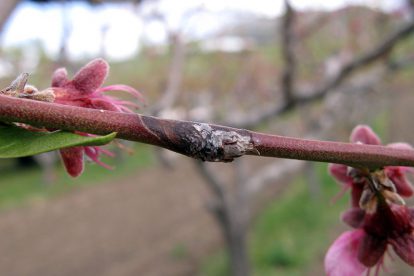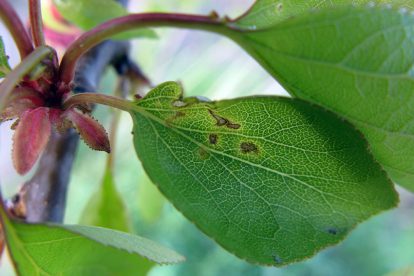In this Issue:
- Apple, Pear: fire blight
- Apricot, Peach/Nectarine: coryneum blight
APPLE, PEAR
Fire Blight
Risk is high; infections may happen on blossoms in warm, wet weather


Fire blight is a bacterial plant disease that causes infections through open flowers on apple and pear (plus other ornamentals such as crabapple, ornamental pear, and hawthorn). Infections occur during warm, wet days. We use a model to predict fire blight risk.
Based on the model, there is a very high potential for infection on open blossoms this week for some locations in Utah. Fire blight is a disease that needs moisture to cause infection, which can come from dew, or a short rainfall (predicted for some areas on Monday, but check your local forecast). Where fire blight has been a problem in past years, it is better to be safe and protect the blossoms of young trees especially.
The infection risk (which only applies when blossoms are open) is shown for counties below for May 6 – May 9. On May 10, the risk reduces to “Caution” for most counties:
- Box Elder, Cache, Uintah, and Weber: CAUTION – no treatment needed
- Carbon and Utah: HIGH to EXTREME Risk – if open flowers, apply treatment May 6 or 7
- Davis, Salt Lake, Sanpete, Sevier, Tooele: HIGH – no treatment needed unless rains occur on May 7 or 8 and there is a history of fire blight in the area
- Beaver, Millard, and Iron: EXTREME to EXCEPTIONAL Risk – apply to open blossoms May 6 or 7
You can watch fire blight predictions on Utah TRAPs by selecting a location closest to you, and then selecting “fire blight” under the Pest drop-down menu.
Treatment
- For commercial producers, most areas (except the southern part of Utah County, which has resistance) can use streptomycin. Where resistance occurs, producers should use oxytetracycline (MycoShield) and/or Kasumin. One application can be a mix of oxytetracycline and streptomycin.
- Most diligent backyard growers should not need to apply an antibiotic. (Although if necessary, most garden centers carry streptomycin.) Instead, monitor trees closely starting two weeks after full bloom (which is when infections start to become visible). Prune out new infections immediately (on a dry day).
Peach/Nectarine, Apricot
Coryneum Blight
If coryneum blight is a problem on your peach, nectarine, or apricot trees, note that one of the most important times to apply a fungicide is the shuck split stage (see image above).
This pathogen is spread primarily by rain, and optimal conditions for infection are when temperatures are from 70 to 80°F.
Commercial growers can find options by clicking here.
Backyard growers can use one of the following:
- Spectracide Immunox or Fertilome F-Stop (same ingredient)
- Daconil (or related; containing chlorothalonil) Note that chlorothalonil cannot be used between post-shuck split and harvest.
- Captan




